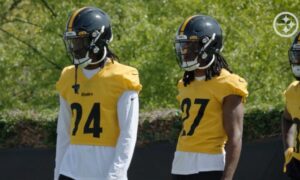In case you happen to be a reporter covering the Pittsburgh Steelers, you might want to read this before interviewing their new running back, Najee Harris. Particularly if you have any intentions of asking him about his receiving skills.
Regular beat writer Dale Lolley learned the hard way after he asked the Steelers’ first-round pick if one of the reasons that he decided to return to Alabama last season was to work on his hands and his receiving ability before declaring for the draft.
“Bro, what?”, was the response that he got back, with a look of fatigued agitation. “Do you always cover the Pittsburgh Steelers?”, he followed up, and seemed to be disappointed when the response came in the affirmative.
“I’ve always been catching the ball. The reason I say this is because every time somebody asks this question”, he went on, as he was asked about a one-handed catch that he made during rookie minicamp.
“I always do that. Not to brag or nothing, but it wasn’t luck, I can tell you that. Since y’all was watching, I’ll do it again for you. It’s not something I ‘work on’, I’ve been doing that since middle school. I’ve got big hands, man”.
Lolley certainly isn’t the first person this offseason to get it from Harris when it was implied that he suddenly improved his receiving skills by a significant margin over the course of the past year. Back in April before the draft, he said that ESPN’s Todd McShay “could kiss my ass” for implying as much.
“It’s not because I can’t catch. It’s because I never had the opportunity to catch”, he said at the time in an interview on Adam Schefter’s podcast. “Now, next year, senior year, I’m used more in the pass game because Ruggs and Jeudy left, so now my role steps up in the pass game, and also running game, and also pass blocking, because there’s nobody on the edge really other than the two guys we got”.
During the 2019 season, Harris caught 27 passes for 304 yards and scored seven touchdowns. Last season, he caught 43 passes for 425 yards and four touchdowns. He only had 10 receptions combined during his first two seasons, for 52 yards.
The two running backs with whom he has drawn the most comparisons are Le’Veon Bell and Matt Forte, neither of whom had huge roles in the passing game during their college careers, though Forte averaged about 26 receptions per season for 245 yards and a touchdown. Both of them exploited greater opportunities to catch the ball at the NFL level and became recognized as two of the best receiving backs of the era.








